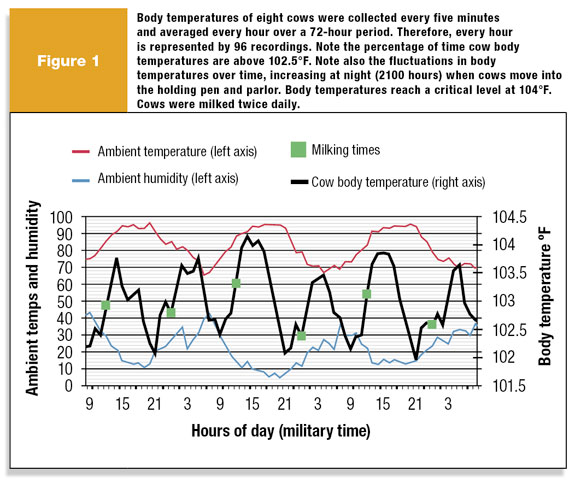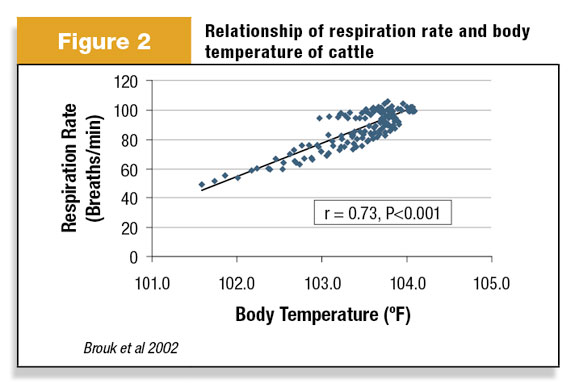The economic consequences of heat stress to the dairy industry have been calculated to be approximately $900 million annually. This sum reflects not only milk production decline, but reproductive losses, increased lameness, prematurely replacing animals in the herd, rumen acidosis, a decrease in milk fat, premature calving, retained placenta and many other health implications. While many producers consider only the decline in milk production in the economics of heat stress, the losses are indeed greater.
Milk production will decline depending on the severity and longevity of the heat stress period. Additionally, there is an accompanying “lag” in return to a normal milk production and reproductive efficiency. Evaluation of economic return from heat abatement strategies should include both the heat stress period and the lag period of sub-optimal performance following heat stress.
Heat stress can produce serious manifestations in the dairy cow, resulting in (but not limited to) effects such as:
• Lower production
• Rumen acidosis
• Milk fat depression
• Poor reproduction
• Laminitis/lameness
• Lowered immune system
• Mastitis
• Transition disease (RP, DA, etc.)
• Lower body condition score (BCS)
Dairy cow heat production
The lactating dairy cow’s optimal environmental temperature is 40°F to 60°F.
Since heat stress is a product of both temperature and humidity, cows could potentially experience heat stress at 72°F. Depending on milk production, cows can produce 4,500 to 6,000 BTU per hour. This heat production is equivalent to the output of a 1500-watt hair dryer during the same time period. The most hostile environment on the farm is the holding pen, when cows are crowded and their ability to dissipate heat is compromised by their close proximity.
Reproductive consequences
From day one through day six after breeding, the embryo is highly susceptible to heat stress and increased body temperature. Body temperatures that exceed 102.2°F may cause the loss of early pregnancy in cows. This does not mean other periods during gestation are not susceptible to heat stress and loss of pregnancy. The period just prior to freshening is also a period of high probability of calf loss during heat stress. Cows under the influence of heat stress may calve 10 to 14 days before their anticipated due date, leading to poor performance in early lactation.
Heat audits
Heat stress can be monitored much like milk production, mastitis, reproduction and many other parameters on the farm. Heat audits may be considered to determine the severity of heat stress on the farm prior to the construction of heat abatement systems or as an audit of systems after they are installed. An audit could be used to more efficiently use the heat abatement system by adjusting water-soaking on/off cycles at the feedline or adjusting cycles in the holding pen.

The graph in Figure 1 is an audit conducted in one of five pens of cows in central Utah prior to the installation of a heat abatement system. It charts body temperatures relative to ambient temperature and humidity in eight high-production cows contained within one pen, recorded over 72 hours, in July 2007. Recall that body temperatures above 102.2°F will impact the early developing embryo. Cows are experiencing early heat stress at approximately 102.5°F.
Body temperatures of eight cows were collected every five minutes and averaged every hour over a 72-hour period. Therefore, every hour is represented by 96 recordings. Note the percentage of time cow body temperatures are above 102.5°F. Note also the fluctuations in body temperatures over time, increasing at night (21:00 hours) when cows move into the holding pen and parlor. Body temperatures reach a critical level at 104°F. Cows were milked twice daily.
Respiration rate and body temperature
Monitoring cattle body temperature does not require a thermometer or recording device. The accompanying graph indicates a linear relationship between body temperatures and respiration rates (see Figure 2 ).
As body temperatures increase, respiration rate increases proportionately. Monitor the respiration rate by watching the movement of the cow’s flank and rib area during respiration exchange. Observe the cow’s nostrils for inhalation and exhalation to count the respiration rate. If cows are open-mouth breathing, observe movement of the cheeks. Our observation has been that cows open-mouth breathing are above 104°F body temperature.

Record the respiration rate of eight to 10 cows in a respective pen. This can be done with each cow for 20 seconds, then multiplying this number by three to obtain respiration rate per cow per minute. Appropriate monitoring times are before and after cows move into the holding pen. Select a few cows to observe prior to movement into the holding pen and then monitor cows on exit.
Determine whether the cows’ respiratory rates have increased. Monitor cows in mid to late afternoon when ambient temperatures are increased. Also monitor cows late in the evening when ambient temperatures have subsided but humidity has started to increase in the barns.
Remember, barns have moisture from urine, fecal matter and cattle respiration, thereby increasing moisture levels in the barn above outside humidity levels. This increased humidity leads to increased temperature/heat index (THI) and heat stress. PD
References omitted due to space but are available upon request by sending an email to editor@progressivedairy.com .

-
Tom Bailey
- Technical Consultant
- Elanco Animal Health
- Email Tom Bailey





